Abstract
Sera from 159 men attending the sexually transmitted disease clinic at Karolinska Hospital, Stockholm, Sweden, were analyzed for the presence of immunoglobulin A (IgA) and IgG antibodies to a panel of synthetic peptides derived from the E2, L1, and L2 regions of the human papillomavirus types 1 (HPV 1), 6, 8, 11, 16, 18, 31, and 33. The study subjects were divided into three groups: (i) asymptomatic men with no history of genital warts who served as controls, (ii) men with visible condylomata, and (iii) men who had previously been afflicted with condylomata. There were no significant differences in antibody titers for any of the HPV 6- or 11-derived peptides among patients with current condylomata and the controls. For the peptide from L1 of HPV 6, there was an increase in the IgG titers among men with previous condylomata compared with the titers for the controls (52% versus 27% seropositivity; P less than 0.05). Also, for the peptide from L2 of HPV 6, there was an increase in the IgG titers among men who had been afflicted with condylomata previously (P less than 0.05). Increased IgA antibody titers against an HPV 16-derived peptide and an HPV 18-derived peptide were also detected. For the peptides from L1 and L2 of HPV 6, the study was extended to an additional group of 127 males attending the sexually transmitted disease clinic at Huddinge Hospital in southern Stockholm. Again, significantly increased antibody levels were detected only for IgG and only among asymptomatic men with a history of condylomata (P < 0.01 for the L1 peptide and P < 0.05 for the L2 peptide). The results suggest that the IgG response against the late proteins of HPV 6 reflects mainly previous exposure to the virus rather than ongoing viral disease.
Full text
PDF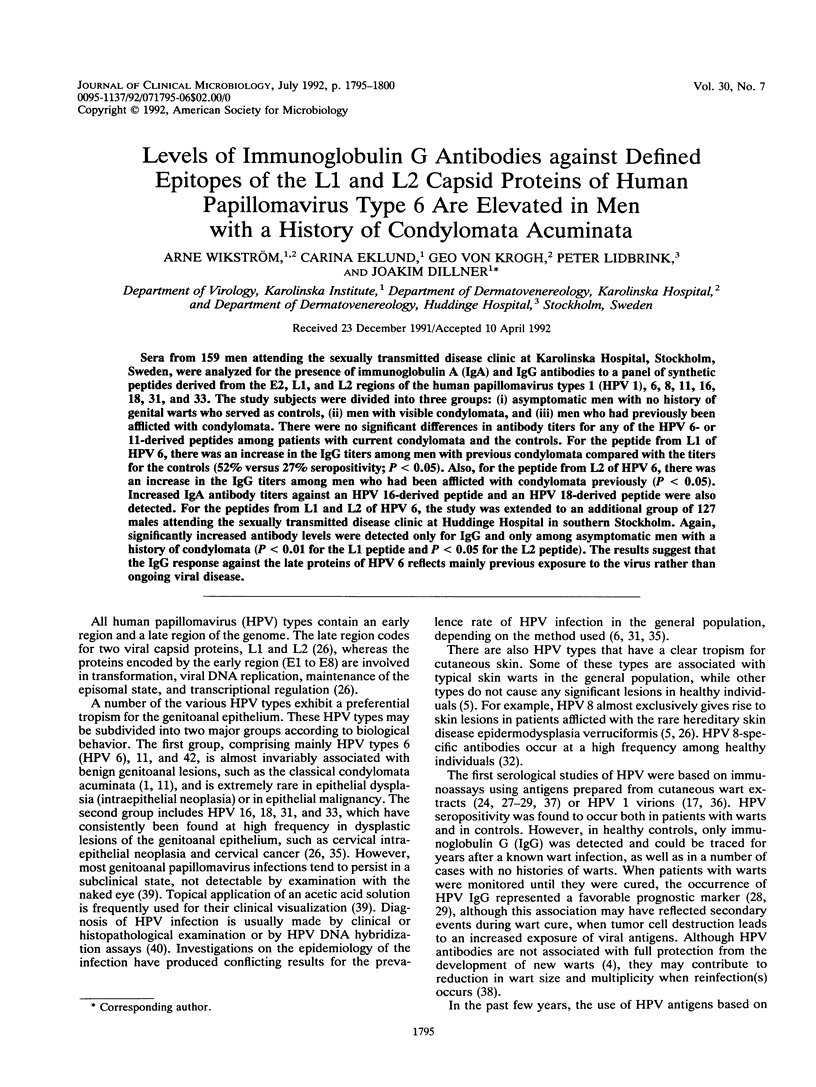
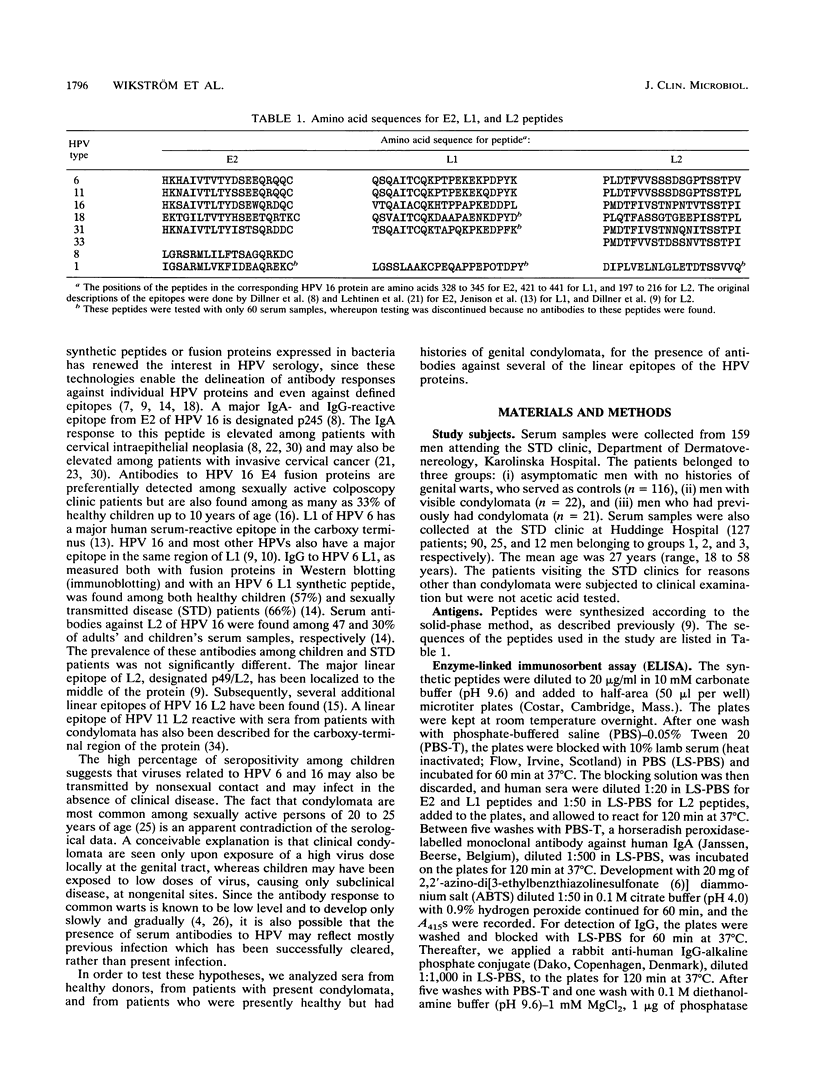
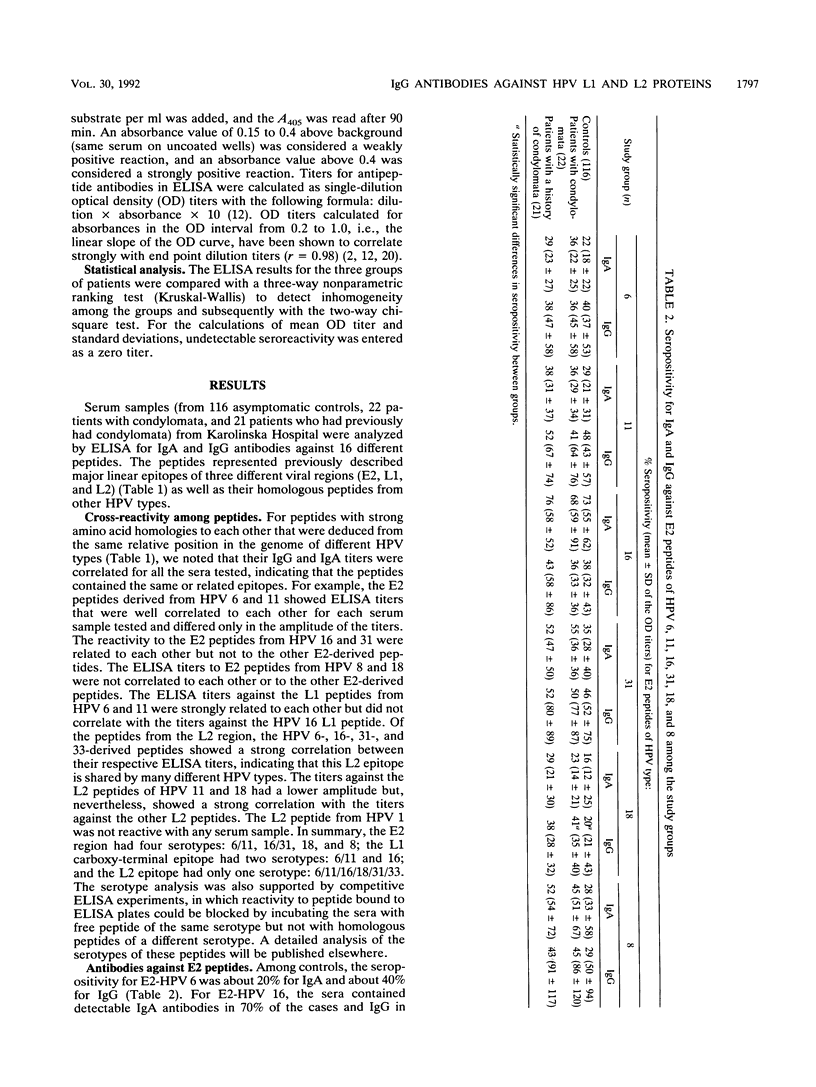
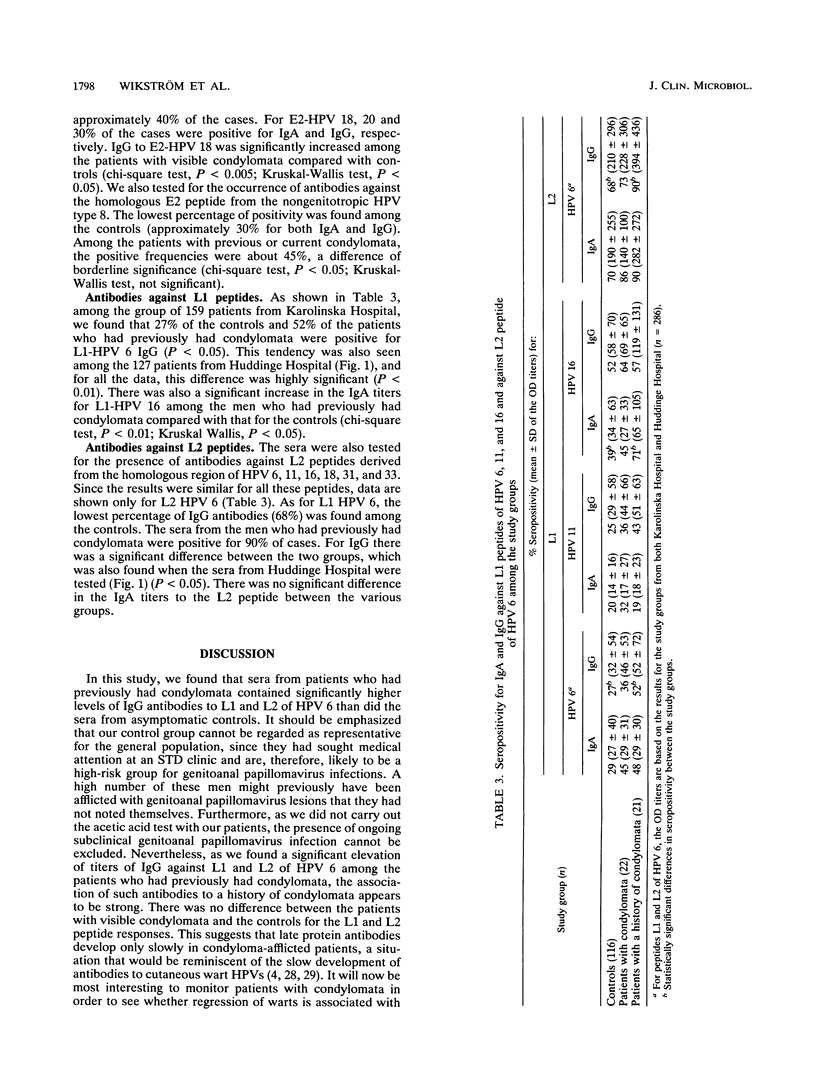
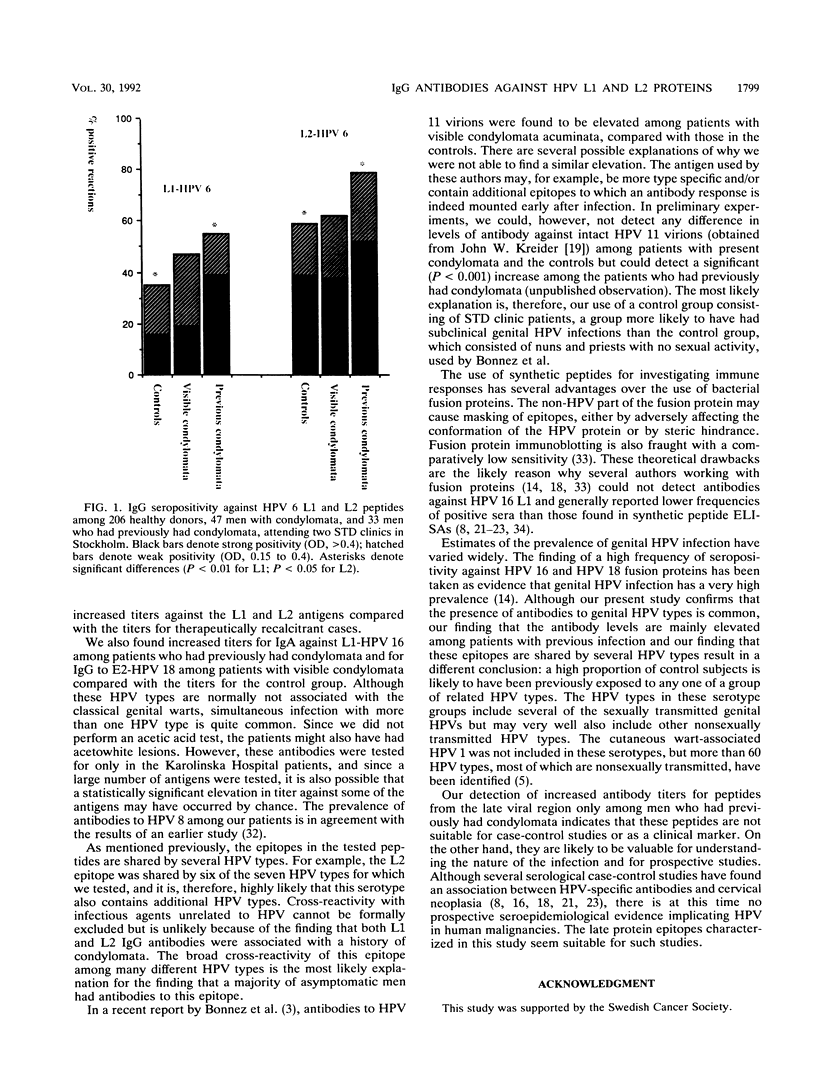
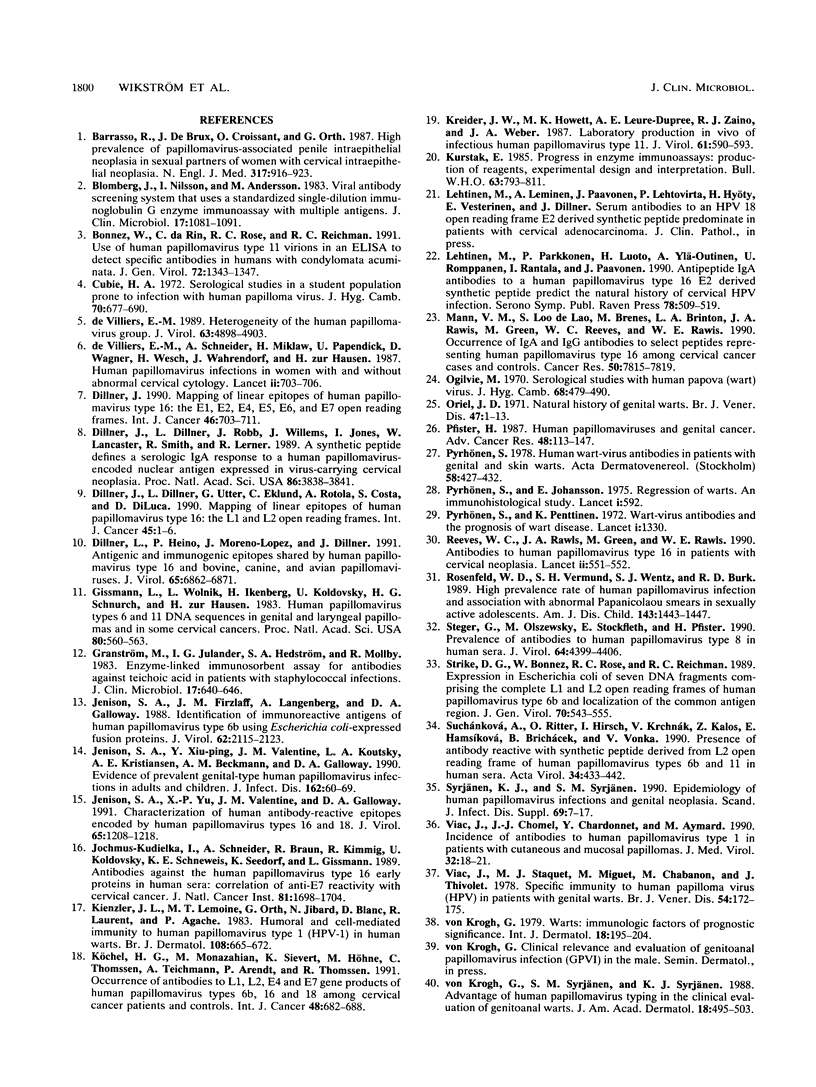
Selected References
These references are in PubMed. This may not be the complete list of references from this article.
- Barrasso R., De Brux J., Croissant O., Orth G. High prevalence of papillomavirus-associated penile intraepithelial neoplasia in sexual partners of women with cervical intraepithelial neoplasia. N Engl J Med. 1987 Oct 8;317(15):916–923. doi: 10.1056/NEJM198710083171502. [DOI] [PubMed] [Google Scholar]
- Blomberg J., Nilsson I., Andersson M. Viral antibody screening system that uses a standardized single dilution immunoglobulin G enzyme immunoassay with multiple antigens. J Clin Microbiol. 1983 Jun;17(6):1081–1091. doi: 10.1128/jcm.17.6.1081-1091.1983. [DOI] [PMC free article] [PubMed] [Google Scholar]
- Bonnez W., Da Rin C., Rose R. C., Reichman R. C. Use of human papillomavirus type 11 virions in an ELISA to detect specific antibodies in humans with condylomata acuminata. J Gen Virol. 1991 Jun;72(Pt 6):1343–1347. doi: 10.1099/0022-1317-72-6-1343. [DOI] [PubMed] [Google Scholar]
- Cubie H. A. Serological studies in a student population prone to infection with human papilloma virus. J Hyg (Lond) 1972 Dec;70(4):677–690. doi: 10.1017/s0022172400022531. [DOI] [PMC free article] [PubMed] [Google Scholar]
- Dillner J., Dillner L., Robb J., Willems J., Jones I., Lancaster W., Smith R., Lerner R. A synthetic peptide defines a serologic IgA response to a human papillomavirus-encoded nuclear antigen expressed in virus-carrying cervical neoplasia. Proc Natl Acad Sci U S A. 1989 May;86(10):3838–3841. doi: 10.1073/pnas.86.10.3838. [DOI] [PMC free article] [PubMed] [Google Scholar]
- Dillner J. Mapping of linear epitopes of human papillomavirus type 16: the E1, E2, E4, E5, E6 and E7 open reading frames. Int J Cancer. 1990 Oct 15;46(4):703–711. doi: 10.1002/ijc.2910460426. [DOI] [PubMed] [Google Scholar]
- Dillner L., Heino P., Moreno-Lopez J., Dillner J. Antigenic and immunogenic epitopes shared by human papillomavirus type 16 and bovine, canine, and avian papillomaviruses. J Virol. 1991 Dec;65(12):6862–6871. doi: 10.1128/jvi.65.12.6862-6871.1991. [DOI] [PMC free article] [PubMed] [Google Scholar]
- Gissmann L., Wolnik L., Ikenberg H., Koldovsky U., Schnürch H. G., zur Hausen H. Human papillomavirus types 6 and 11 DNA sequences in genital and laryngeal papillomas and in some cervical cancers. Proc Natl Acad Sci U S A. 1983 Jan;80(2):560–563. doi: 10.1073/pnas.80.2.560. [DOI] [PMC free article] [PubMed] [Google Scholar]
- Granström M., Julander I. G., Hedström S. A., Möllby R. Enzyme-linked immunosorbent assay for antibodies against teichoic acid in patients with staphylococcal infections. J Clin Microbiol. 1983 Apr;17(4):640–646. doi: 10.1128/jcm.17.4.640-646.1983. [DOI] [PMC free article] [PubMed] [Google Scholar]
- Jenison S. A., Firzlaff J. M., Langenberg A., Galloway D. A. Identification of immunoreactive antigens of human papillomavirus type 6b by using Escherichia coli-expressed fusion proteins. J Virol. 1988 Jun;62(6):2115–2123. doi: 10.1128/jvi.62.6.2115-2123.1988. [DOI] [PMC free article] [PubMed] [Google Scholar]
- Jenison S. A., Yu X. P., Valentine J. M., Galloway D. A. Characterization of human antibody-reactive epitopes encoded by human papillomavirus types 16 and 18. J Virol. 1991 Mar;65(3):1208–1218. doi: 10.1128/jvi.65.3.1208-1218.1991. [DOI] [PMC free article] [PubMed] [Google Scholar]
- Jenison S. A., Yu X. P., Valentine J. M., Koutsky L. A., Christiansen A. E., Beckmann A. M., Galloway D. A. Evidence of prevalent genital-type human papillomavirus infections in adults and children. J Infect Dis. 1990 Jul;162(1):60–69. doi: 10.1093/infdis/162.1.60. [DOI] [PubMed] [Google Scholar]
- Jochmus-Kudielka I., Schneider A., Braun R., Kimmig R., Koldovsky U., Schneweis K. E., Seedorf K., Gissmann L. Antibodies against the human papillomavirus type 16 early proteins in human sera: correlation of anti-E7 reactivity with cervical cancer. J Natl Cancer Inst. 1989 Nov 15;81(22):1698–1704. doi: 10.1093/jnci/81.22.1698. [DOI] [PubMed] [Google Scholar]
- Kienzler J. L., Lemoine M. T., Orth G., Jibard N., Blanc D., Laurent R., Agache P. Humoral and cell-mediated immunity to human papillomavirus type 1 (HPV-1) in human warts. Br J Dermatol. 1983 Jun;108(6):665–672. doi: 10.1111/j.1365-2133.1983.tb01078.x. [DOI] [PubMed] [Google Scholar]
- Kreider J. W., Howett M. K., Leure-Dupree A. E., Zaino R. J., Weber J. A. Laboratory production in vivo of infectious human papillomavirus type 11. J Virol. 1987 Feb;61(2):590–593. doi: 10.1128/jvi.61.2.590-593.1987. [DOI] [PMC free article] [PubMed] [Google Scholar]
- Kurstak E. Progress in enzyme immunoassays: production of reagents, experimental design, and interpretation. Bull World Health Organ. 1985;63(4):793–811. [PMC free article] [PubMed] [Google Scholar]
- Köchel H. G., Monazahian M., Sievert K., Höhne M., Thomssen C., Teichmann A., Arendt P., Thomssen R. Occurrence of antibodies to L1, L2, E4 and E7 gene products of human papillomavirus types 6b, 16 and 18 among cervical cancer patients and controls. Int J Cancer. 1991 Jul 9;48(5):682–688. doi: 10.1002/ijc.2910480509. [DOI] [PubMed] [Google Scholar]
- Mann V. M., de Lao S. L., Brenes M., Brinton L. A., Rawls J. A., Green M., Reeves W. C., Rawls W. E. Occurrence of IgA and IgG antibodies to select peptides representing human papillomavirus type 16 among cervical cancer cases and controls. Cancer Res. 1990 Dec 15;50(24):7815–7819. [PubMed] [Google Scholar]
- Ogilvie M. M. Serological studies with human papova (wart) virus. J Hyg (Lond) 1970 Sep;68(3):479–490. doi: 10.1017/s0022172400042388. [DOI] [PMC free article] [PubMed] [Google Scholar]
- Oriel J. D. Natural history of genital warts. Br J Vener Dis. 1971 Feb;47(1):1–13. doi: 10.1136/sti.47.1.1. [DOI] [PMC free article] [PubMed] [Google Scholar]
- Pfister H. Human papillomaviruses and genital cancer. Adv Cancer Res. 1987;48:113–147. doi: 10.1016/s0065-230x(08)60691-0. [DOI] [PubMed] [Google Scholar]
- Pyrhönen S. Hunan wart-virus antibodies in patients with genital and skin warts. Acta Derm Venereol. 1978;58(5):427–432. [PubMed] [Google Scholar]
- Pyrhönen S., Johansson E. Regression of warts. An immunological study. Lancet. 1975 Mar 15;1(7907):592–596. doi: 10.1016/s0140-6736(75)91880-2. [DOI] [PubMed] [Google Scholar]
- Pyrhönen S., Penttinen K. Wart-virus antibodies and the prognosis of wart disease. Lancet. 1972 Dec 23;2(7791):1330–1332. doi: 10.1016/s0140-6736(72)92776-6. [DOI] [PubMed] [Google Scholar]
- Reeves W. C., Rawls J. A., Green M., Rawls W. E. Antibodies to human papillomavirus type 16 in patients with cervical neoplasia. Lancet. 1990 Mar 3;335(8688):551–552. doi: 10.1016/0140-6736(90)90793-5. [DOI] [PubMed] [Google Scholar]
- Rosenfeld W. D., Vermund S. H., Wentz S. J., Burk R. D. High prevalence rate of human papillomavirus infection and association with abnormal papanicolaou smears in sexually active adolescents. Am J Dis Child. 1989 Dec;143(12):1443–1447. doi: 10.1001/archpedi.1989.02150240065018. [DOI] [PubMed] [Google Scholar]
- Steger G., Olszewsky M., Stockfleth E., Pfister H. Prevalence of antibodies to human papillomavirus type 8 in human sera. J Virol. 1990 Sep;64(9):4399–4406. doi: 10.1128/jvi.64.9.4399-4406.1990. [DOI] [PMC free article] [PubMed] [Google Scholar]
- Strike D. G., Bonnez W., Rose R. C., Reichman R. C. Expression in Escherichia coli of seven DNA fragments comprising the complete L1 and L2 open reading frames of human papillomavirus type 6b and localization of the 'common antigen' region. J Gen Virol. 1989 Mar;70(Pt 3):543–555. doi: 10.1099/0022-1317-70-3-543. [DOI] [PubMed] [Google Scholar]
- Suchánková A., Ritter O., Hirsch I., Krchnák V., Kalos Z., Hamsíková E., Brichácek B., Vonka V. Presence of antibody reactive with synthetic peptide derived from L2 open reading frame of human papillomavirus types 6b and 11 in human sera. Acta Virol. 1990 Sep;34(5):433–442. [PubMed] [Google Scholar]
- Syrjänen K., Syrjänen S. Epidemiology of human papilloma virus infections and genital neoplasia. Scand J Infect Dis Suppl. 1990;69:7–17. [PubMed] [Google Scholar]
- Uyterlinde A. M., Baak J. P., Schipper N. W., Peterse H., Matze E., Meijer C. J. Further evaluation of the prognostic value of morphometric and flow cytometric parameters in breast-cancer patients with long follow-up. Int J Cancer. 1990 Jan 15;45(1):1–7. doi: 10.1002/ijc.2910450102. [DOI] [PubMed] [Google Scholar]
- Viac J., Chomel J. J., Chardonnet Y., Aymard M. Incidence of antibodies to human papillomavirus type 1 in patients with cutaneous and mucosal papillomas. J Med Virol. 1990 Sep;32(1):18–21. doi: 10.1002/jmv.1890320104. [DOI] [PubMed] [Google Scholar]
- Viac J., Staquet M. J., Miguet M., Chabanon M., Thivolet J. Specific immunity to human papilloma virus (HPV) in patients with genital warts. Br J Vener Dis. 1978 Jun;54(3):172–175. doi: 10.1136/sti.54.3.172. [DOI] [PMC free article] [PubMed] [Google Scholar]
- de Villiers E. M. Heterogeneity of the human papillomavirus group. J Virol. 1989 Nov;63(11):4898–4903. doi: 10.1128/jvi.63.11.4898-4903.1989. [DOI] [PMC free article] [PubMed] [Google Scholar]
- de Villiers E. M., Wagner D., Schneider A., Wesch H., Miklaw H., Wahrendorf J., Papendick U., zur Hausen H. Human papillomavirus infections in women with and without abnormal cervical cytology. Lancet. 1987 Sep 26;2(8561):703–706. doi: 10.1016/s0140-6736(87)91072-5. [DOI] [PubMed] [Google Scholar]
- von Krogh G., Syrjänen S. M., Syrjänen K. J. Advantage of human papillomavirus typing in the clinical evaluation of genitoanal warts. Experience with the in situ deoxyribonucleic acid hybridization technique applied on paraffin sections. J Am Acad Dermatol. 1988 Mar;18(3):495–503. doi: 10.1016/s0190-9622(88)70072-9. [DOI] [PubMed] [Google Scholar]
- von Krogh G. Warts: immunologic factors of prognostic significance. Int J Dermatol. 1979 Apr;18(3):195–204. doi: 10.1111/ijd.1979.18.3.195. [DOI] [PubMed] [Google Scholar]


